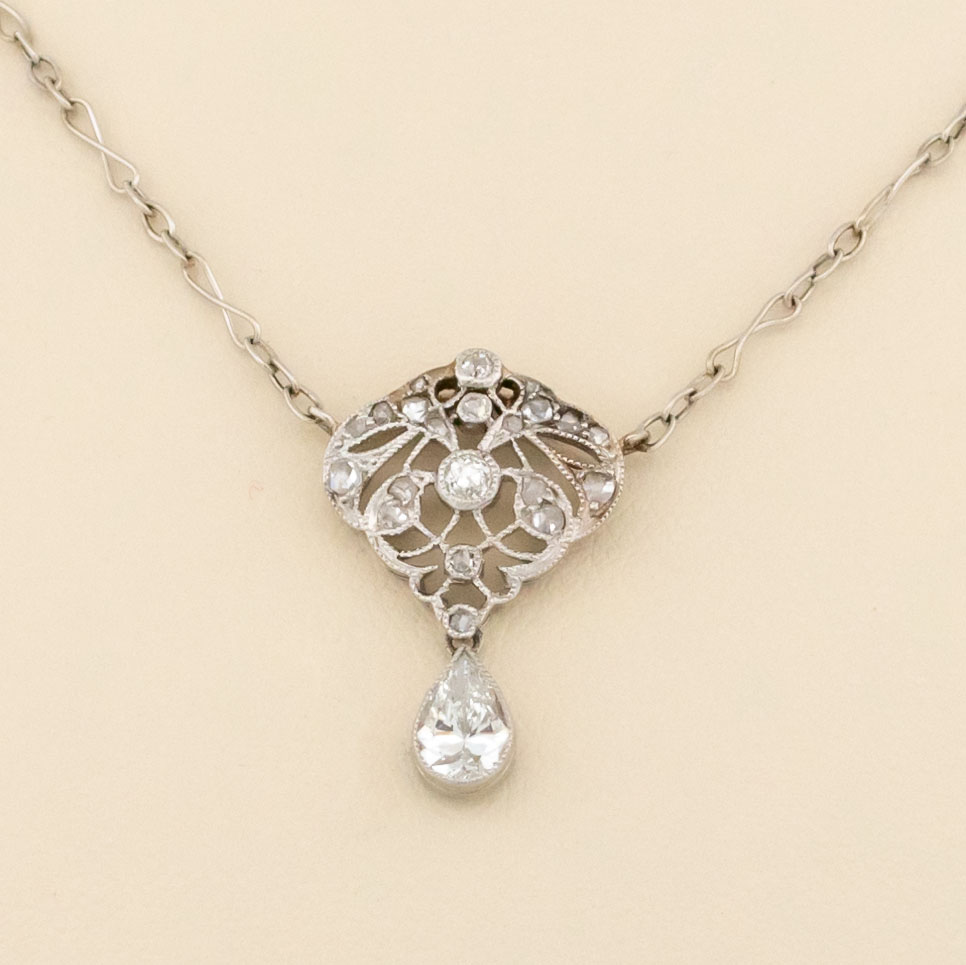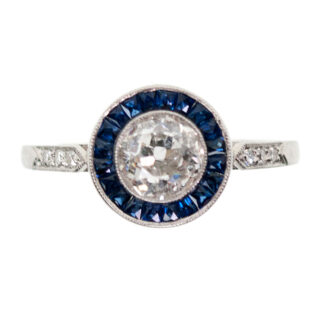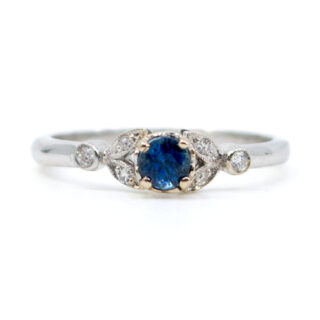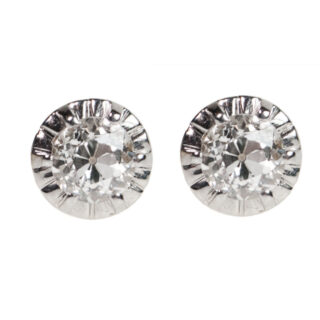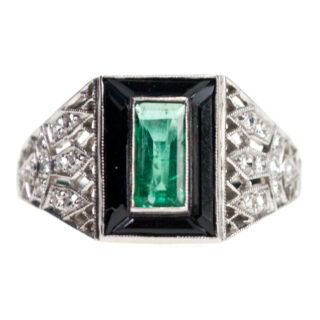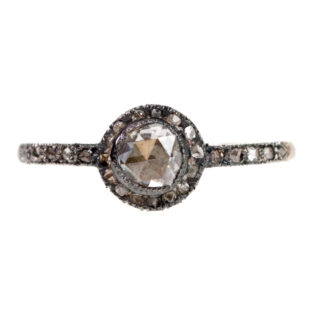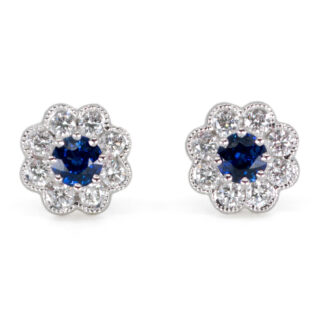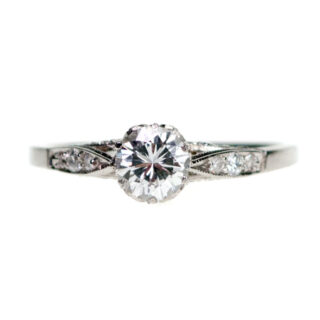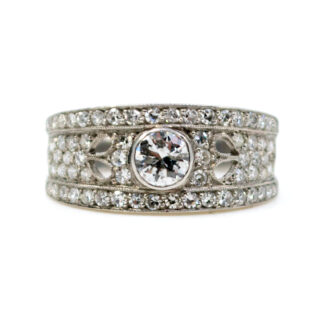This Edwardian-era necklace is a testament to the beauty and elegance of vintage jewelry. Crafted with approx. 0.50ct. pear cut (h vs1) and old-mine-cut diamonds, this necklace exudes luxury and sophistication. The use of platinum in its construction ensures that this necklace will withstand the test of time and remain a cherished piece for generations to come. Wear it to add a touch of vintage glamour to any outfit.
Details: ±0.50ct. Pear cut (H VS1) Diamond, Old-mine-cut diamond, Platinum Necklace *.
Dimensions: H 42 x 1.4 cm.
Weight in grams: 3.
Condition: Very good condition – slightly used with small signs of wear.
Shipping and Pickup: This glorious piece ships from our store located in the center of Amsterdam, The Netherlands. We offer both registered shipping and local pickup at our store. In the case of local pickup, any applicable shipping costs will be refunded.
About Us: Add some sparkle to your style with Binenbaum.com. We offer a stunning selection of antique and vintage jewelry that you won’t find anywhere else. From timeless rings and dazzling necklaces to unique brooches, we have something for every taste and occasion. Visit our website today and treat yourself to a piece of history.
| Design Era | |
|---|---|
| Design & Historical Context | The Edwardian period, which began in 1901 with the death of Queen Victoria and the ascension of her son King Edward, was a time of opulence and extravagance. This was reflected in the jewelry of the time, which often featured expensive gems such as diamonds, emeralds, and rubies in intricate and ornate designs. The jewelry of the Edwardian period was characterized by its delicate and feminine aesthetic, with a focus on intricate details and intricate metalwork. Many of the pieces from this period were inspired by the Art Nouveau movement, which favored natural and organic forms, as well as the Rococo style, which was characterized by elaborate and ornate decorative elements. Overall, the Edwardian period was a time of great creativity and innovation in the world of jewelry, and many of the pieces produced during this time are still highly prized and collected today. |
| Key Materials | |
| Materials & Craftsmanship | Diamond Diamond is a gemstone that is composed of chemically pure carbon and has a cubic crystal structure. It is known for its extreme hardness, which is a result of the strong chemical bonds between the carbon atoms. Diamonds are valued for their brilliance, fire, and beauty, and are often perceived as being colorless. However, diamonds can actually occur in every color, including yellow, green, pink, blue, purple, and red. The value of a diamond is determined by the four Cs: color, clarity, carat weight, and cut. The color of a diamond is measured on a scale ranging from D to Z, with D being the most colorless and desirable. Clarity refers to the relative number, type, and visibility of inclusions in the diamond, and is designated on a scale ranging from Flawless to Included. Carat weight is a measure of the weight of a diamond, with one carat being equivalent to 1/5 of a gram or 200 milligrams. The cut of a diamond refers to both the shape of the finished diamond and the determination of how well the diamond was fashioned, its proportions, and finishing details. Diamonds are often used in jewelry, such as engagement and wedding rings, earrings, pendants, and other types of adornment. They are also used in industrial applications due to their hardness, which makes them ideal for use in cutting and drilling tools. In addition to their beauty and practical uses, diamonds are also considered to be symbols of love and commitment, making them popular choices for use in engagement and wedding rings. They are also often given as gifts to mark special occasions, such as anniversaries and birthdays. Old-mine-cut diamond The old mine cut is a type of diamond cut that was popular in the 1700s and was most prevalent during the Georgian and Victorian eras. It is similar to today's cushion cut and is characterized by a squarish girdle with gently rounded corners, a high crown, a small table, and a large, flat culet. Old mine cut diamonds are known for their antique charm and character, and they are often used in vintage-style jewelry. They have a softer, more romantic look than modern diamond cuts, which tend to have more precise geometry and a higher level of brilliance. Old mine cut diamonds are typically less expensive than diamonds with more modern cuts because they require less labor and material to produce. They are often used as accent stones in jewelry designs or as the main gemstone in vintage-style pieces. Despite their lower price, old mine cut diamonds can still be beautiful and valuable, and they are a popular choice for those who appreciate the unique charm and character of antique jewelry. The rose cut is a type of diamond cut that was popular in the 1500s and remained common during the Georgian and Victorian eras. It is characterized by a flat bottom with a dome-shaped crown that rises to a single apex, giving the diamond a shape that resembles a rose bud. Rose cut diamonds can have anywhere from 3 to 24 facets, which are small, flat surfaces that are cut into the diamond to create a specific shape and enhance its sparkle and brilliance. Unlike modern diamond cuts, such as the round brilliant or princess cut, the rose cut has a lower crown and a less brilliant appearance. It is a more primitive diamond cut that was used before the development of more advanced cutting techniques. However, it is still a popular choice for collectors of antique jewelry and for those who appreciate the timeless beauty of vintage cuts. Rose cut diamonds are typically less expensive than diamonds with more modern cuts because they require less labor and material to produce. They are often used as accent stones in jewelry designs or as the main gemstone in vintage-style pieces. Despite their lower price, rose cut diamonds can still be beautiful and valuable, and they are a popular choice for those who appreciate the unique charm and character of antique jewelry. Platinum Platinum is a white metallic element that is known for its strength, durability, and resistance to tarnish and corrosion. It belongs to a group of elements called the platinum group metals, which also includes osmium, iridium, palladium, rhodium, and ruthenium. Platinum is often found in nature as an alloy, which is a mixture of two or more elements. It can be mixed with other platinum group metals or with other elements such as copper, nickel, or cobalt. It wasn't until 1804 that all of the elements in the platinum group were isolated and named, with the exception of osmium, which was not isolated until 1841. Platinum is a highly prized metal that is often used in the manufacture of fine jewelry. It is malleable, meaning that it can be easily molded and shaped, and it is ductile, meaning that it can be drawn into thin wires or sheets. It is also very strong, which makes it suitable for use in a wide range of applications. Platinum is named after the Spanish word "platina," which means "little silver." It is thought to have been named this because of its white metallic luster, which is similar to that of silver. Platinum was first discovered by the Spanish conquistadors in South America, near the Pinto River in present-day Columbia. |
| Dimensions | H 42 x 1.4 cm |
| Gender | |
| Weight (in grams) | 3 |
| Condition | Very good condition – slightly used with small signs of wear |
Enhance the Beauty of Your Jewelry with Proper Care
Wearing your jewelry is a special way to express yourself and add a touch of personal style to any look. However, to ensure your jewelry remains in pristine condition, there are a few simple steps you need to take to keep it looking its best.
General Care Instructions:
Remove jewelry when showering or bathing, especially when at the beach, in the sea or in chlorinated water.
Avoid wearing jewelry while doing physical work such as housekeeping, gardening or exercise.
Storing your jewelry in a dry and cool place will help protect it from moisture, dirt and dust.
Keeping it away from harsh chemicals such as bleach, ammonia and chlorine will help to avoid discoloration and damage.
Cleaning your jewelry regularly with a soft cloth will help to keep it looking shiny and new.
Avoid exposing your jewelry to extreme temperatures, such as leaving it in direct sunlight or near a heater, as this can cause damage.
Handle your jewelry carefully and avoid dropping it, as this can cause the stones to loosen or the metals to scratch.
Finally, if possible, have your jewelry professionally checked and serviced. This will ensure that any potential problems are spotted and fixed before they become worse.
By following these tips, you can enjoy your precious jewelry for many years to come.
Related products
-
Diamond Sapphire Platinum Target Ring 6961-4858
€ 3.995,00 VAT incl. (where applicable) -
Sapphire Diamond 18k Ring 5072-4669
€ 1.695,00 VAT incl. (where applicable) -
Diamond Platinum Solitaire Earrings 5837-1869
€ 5.495,00 VAT incl. (where applicable) -
Diamond Emerald Onyx Platinum Deco Ring 7339-4900
€ 3.895,00 VAT incl. (where applicable) -
Diamond 14k Silver Antique Ring 7311-0718
€ 1.695,00Original price was: € 1.695,00.€ 1.495,00Current price is: € 1.495,00. VAT incl. (where applicable) -
Sapphire Diamond 18k Cluster Earrings 8204-0840
€ 1.495,00 VAT incl. (where applicable) -
Diamond Platinum Solitaire Ring 7243-1935
€ 3.995,00 VAT incl. (where applicable) -
Diamond Platinum Ring 5208-4734
€ 4.695,00 VAT incl. (where applicable)
- Home
- Collection
- Fine Jewelry
- Silver Jewelry
- Silverware
- Boxes
- Candlesticks
- Salt and pepper shakers
- Miniatures
- Salt cellars
- Spoon Set
- Condiments
- Frames
- Napkin Ring
- Spoon
- Oddities
- Cups
- Vases
- Cutlery
- Serving Spoon And Cake Server
- Candlesticks
- Baskets
- Hanukkiah
- Spice Tower
- Yad
- Tea Set
- Sugar Castor
- Napkin Rings
- Wine Bottle Coaster
- Wine Stopper
- Tea Pot
- Jugs
- Rattles
- Hip Flask
- Miscellaneous
- Rings 💍
- About
- Contact

